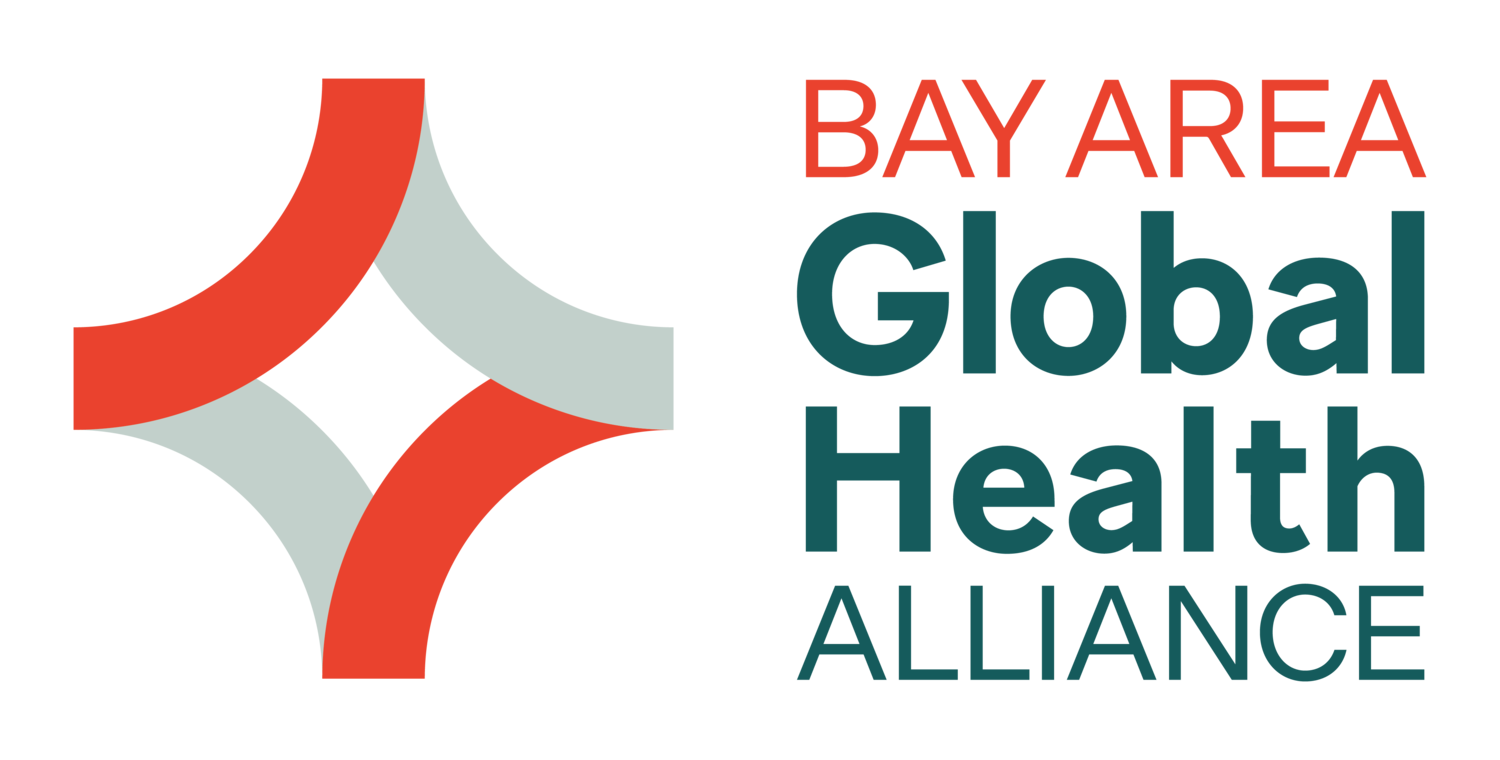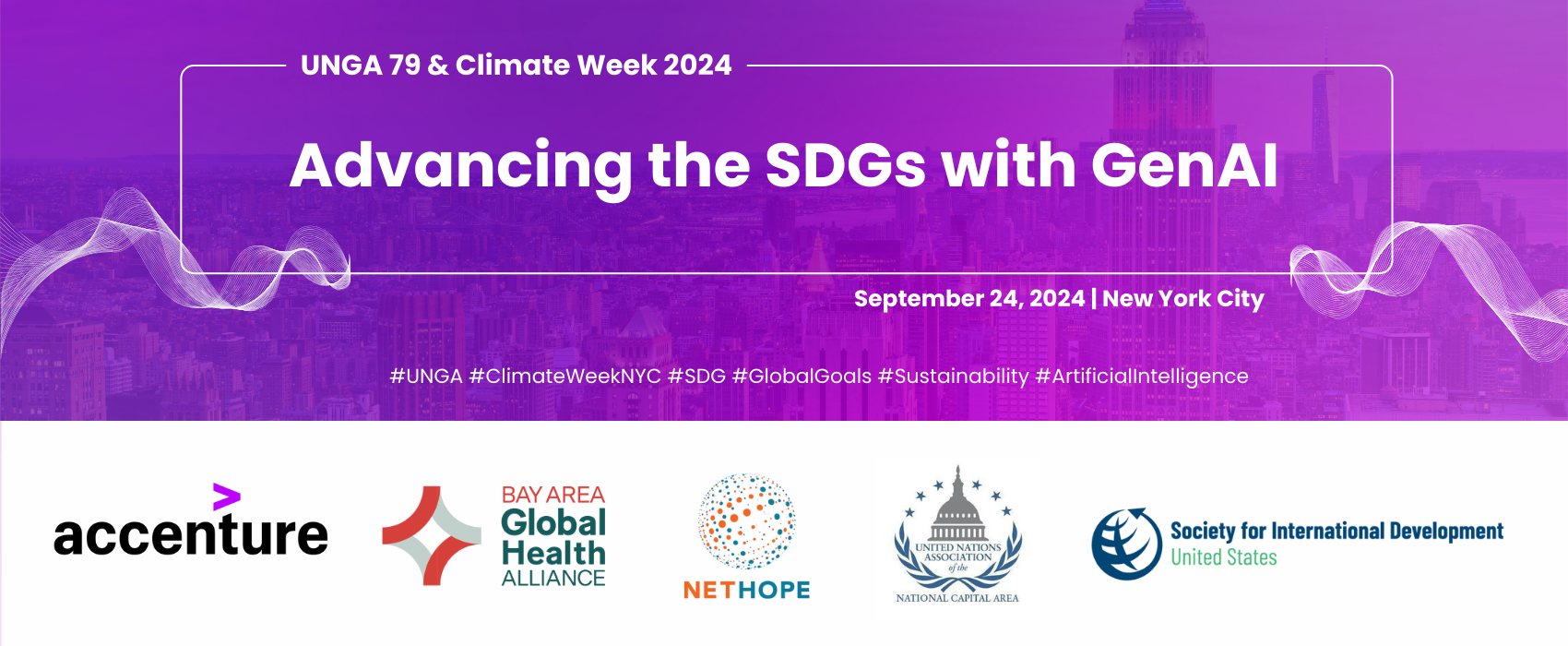As global leaders gathered in New York for UNGA 79 and Climate Week in September to ensure that the Sustainable Development Goals (SDGs) remain at the forefront of the global agenda, on the sidelines, the Bay Area Global Health Alliance, Accenture, NetHope, the Society for International Development United States, and the United Nations Association–National Capital Area co-hosted an evening networking reception on September 24 that explored how the SDGs can be advanced through Generative AI (GenAI).

Pictured from left to right: Roger Ford, Managing Director at Accenture Development Partnerships, Katherine Raphaelson, President of SID-US, Sara Anderson, Executive Director of the Bay Area Global Health Alliance, Lance Pierce, CEO of NetHope, Paula Roland, President of UNA-NCA
The rapid development of GenAI has introduced innovative opportunities to employ interactive technology to advance the SDGs. The networking reception spotlighted organizations that are experts in the technology and innovation space, including Alliance members Google, RAIsonance Inc., Reach Digital Health, Simprints, and Viamo. They showcased inspiring use cases of how GenAI can advance the SDGs, as well as the opportunities and challenges they encountered in the process of utilizing innovative technologies to drive impactful change.
From AI-powered cough analysis for disease screening to hyper-personalized health messaging and biometric IDs for vaccine tracking, these solutions aim to advance health (SDG 3). Meanwhile, Google demonstrated AI applications for education and flood monitoring to support education (SDG 4) and climate action (SDG 13), highlighting the power of AI to address complex global challenges. Their use cases showcased the transformative potential of GenAI and demonstrated how cutting-edge technology is being leveraged to address global challenges with scalable and accessible solutions.
Kitty M. Kolding, RAIsonance Inc. CEO, shared how RAIsonance is “Using AI for Cough Analysis to Screen for & Monitor Respiratory Illness” to advance SDG 3: Good Health and Well-Being. Their AI/ML-powered cough analysis platform is designed for disease detection screening (e.g., TB, Covid, flu, RSV) and supports ongoing monitoring of those with chronic respiratory conditions, such as COPD and asthma, using a mobile app interface. Users cough into the phone app for 8-10 seconds and receive results in 90 seconds. RAIsonance’s cough analysis platform is highly scalable, fast, inexpensive, and portable, and it is being commercialized worldwide. Learn more.
Debbie Rogers, Reach Digital Health CEO, showcased “Reach’s Precision Health Engine: AI for Hyper-Personalisation of Health Messaging,” which advances SDG 3 by predicting the behavior and needs of users on their large-scale messaging platforms and then delivers the most appropriate content to each user. The Precision Health Engine enables Reach to hyper-personalize its services, ensuring that each user has a journey that is unique to them and their health needs, thus improving the chance of behavior change and creating better health outcomes for all. Learn more.

Eje Esangbedo showcases Simprints’ open-source biometric ID
Eje Esangbedo, Simprints director of partnerships, described how Simprints’ open-source biometric ID with privacy at its core advances SDG 3 by “Disrupting Barriers to Vaccination Using AI Biometrics from Birth.” Simprints’ technology provides a safe digital identity that ensures every vaccine, every dollar, and every public good reaches those who need them most. With this technology, Simprints has improved frontline efficiency through 5x faster patient identifications in Ghana, has brought the usable age of infant biometrics down to <9 months, and plans to deploy the world’s first hardwareless AI biometric system for infants and accelerate the algorithm development that works from birth. Learn more.![]()
Stephen Meyer, Viamo director of partnerships, illustrated how Viamo is also advancing SDG 3 through “Generative AI on Phone Call: Digital Solutions for the Next Billion.” Viamo is a search engine for the “next billion” in sub-Saharan Africa, where users without a smartphone or Internet can access the platform to browse for information and discover new products and services. Viamo’s 24 million users access the platform through a free, automated phone call; no Internet, literacy, or smartphone is required, enabling their partners to engage with offline audiences, such as teachers and farmers, interactively and at scale. Learn more.

Maggie Blackwood and Victoria Baxter showcase Google’s LearnLM and Flood Hub
Maggie Blackwood, Google senior partner operations manager, described how Google’s “Learn About X” is advancing SDG 4: Quality Educationby “Making AI Helpful for the Future of Learning and Education.” Billions of people use Google products to learn or discover something new — through Search, YouTube, Gemini, Google Classroom, and more. Guided by the knowledge and experience of experts, educators, and learners, Google has embraced and shaped AI as a teaching, leading, and learning tool. LearnLM is Google’s new family of learning mode, fine-tuned with Gemini. They are creating next-frontier models and applying them to their products to help unlock new learning and teaching experiences. Learn more.
Victoria Baxter, Google head of climate & crisis response partnerships, demonstrated how Google’s Flood Hub platform advances SDG 13: Climate Action in her presentation, “Climate Adaptation: Protecting People from Flooding”. Google’s Flood Hub platform uses key AI/ML technologies and partnerships for flood forecasting and active flood monitoring around the globe, which allows someone to receive the relevant, actionable information needed to take the necessary steps to find safety ahead of time when receiving a “severe flood alert” anywhere in the world. Learn more.
To learn more about GenAI and how our members are employing it to advance global health equity, check out our AI and Global Health series.

